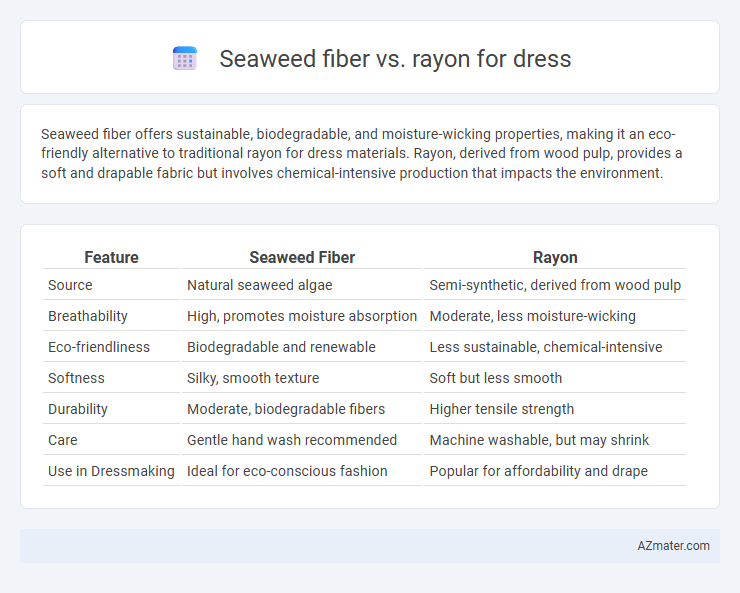Seaweed fiber offers sustainable, biodegradable, and moisture-wicking properties, making it an eco-friendly alternative to traditional rayon for dress materials. Rayon, derived from wood pulp, provides a soft and drapable fabric but involves chemical-intensive production that impacts the environment.
Table of Comparison
| Feature | Seaweed Fiber | Rayon |
|---|---|---|
| Source | Natural seaweed algae | Semi-synthetic, derived from wood pulp |
| Breathability | High, promotes moisture absorption | Moderate, less moisture-wicking |
| Eco-friendliness | Biodegradable and renewable | Less sustainable, chemical-intensive |
| Softness | Silky, smooth texture | Soft but less smooth |
| Durability | Moderate, biodegradable fibers | Higher tensile strength |
| Care | Gentle hand wash recommended | Machine washable, but may shrink |
| Use in Dressmaking | Ideal for eco-conscious fashion | Popular for affordability and drape |
Introduction to Seaweed Fiber and Rayon
Seaweed fiber is an innovative, eco-friendly textile derived from sustainably harvested seaweed, known for its softness, breathability, and natural antibacterial properties. Rayon, a semi-synthetic fiber made from regenerated cellulose, offers excellent drape and versatility but involves chemical processing that can impact environmental sustainability. Comparing seaweed fiber and rayon highlights differences in their production methods, environmental footprints, and functional benefits for dress materials.
Origins and Production Processes
Seaweed fiber is derived from sustainably harvested seaweed, which undergoes an eco-friendly extraction process that preserves natural minerals and reduces chemical use, making it a biodegradable alternative. Rayon, produced from cellulose fibers typically sourced from wood pulp, involves intensive chemical processing including the use of carbon disulfide and sodium hydroxide, raising environmental concerns due to toxic byproducts. The production of seaweed fiber emphasizes renewable marine resources and lower ecological impact, while rayon relies on deforestation and chemical treatments, affecting its sustainability profile for dress materials.
Environmental Impact Comparison
Seaweed fiber offers a more sustainable alternative to rayon due to its biodegradability and renewable source from ocean algae, which requires minimal water and no pesticides during cultivation. Rayon production involves chemically intensive processes using toxic solvents like carbon disulfide, contributing to air and water pollution, whereas seaweed fiber processing is generally less harmful to ecosystems. Choosing seaweed fiber for dresses significantly reduces carbon footprint and environmental pollution compared to conventional rayon fabrics.
Texture and Comfort in Dress Fabrics
Seaweed fiber offers a naturally smooth and silky texture, providing breathable comfort and excellent moisture-wicking properties, making it ideal for lightweight, skin-friendly dresses. Rayon, derived from cellulose, mimics the softness of natural fibers but tends to be less breathable and can sometimes feel heavier or more clingy in humid conditions. Dresses made from seaweed fiber promote a cooler, more comfortable wearing experience due to its eco-friendly, hydrating qualities, while rayon provides a cost-effective alternative with a softer drape but reduced ventilation.
Durability and Longevity
Seaweed fiber offers superior durability compared to rayon, as it is naturally resistant to wear and environmental stress, making it ideal for long-lasting dresses. Rayon, being a semi-synthetic fiber derived from cellulose, tends to weaken with repeated washing and exposure to moisture, reducing its lifespan. Choosing seaweed fiber enhances the longevity of dresses by maintaining fabric integrity and resilience over time.
Moisture Management and Breathability
Seaweed fiber exhibits superior moisture management compared to rayon due to its natural hydrophilic properties that efficiently wick sweat away from the skin, promoting quick drying. Breathability in seaweed fiber fabrics is enhanced by their porous structure, allowing better air circulation and temperature regulation during wear. Conversely, rayon, while soft, tends to retain moisture longer and offers less ventilation, which can lead to discomfort in warm or humid conditions.
Dyeability and Color Retention
Seaweed fiber offers superior dyeability compared to rayon due to its natural polarity and porous structure, allowing for deeper and more uniform color absorption. Its eco-friendly composition enhances color retention, resisting fading even after multiple washes, whereas rayon tends to lose vibrancy over time due to weaker fiber-dye bonding. The inherent moisture-wicking properties of seaweed fiber also contribute to maintaining color intensity under various environmental conditions.
Cost and Market Availability
Seaweed fiber offers an eco-friendly alternative to rayon with a generally higher production cost due to limited large-scale manufacturing and raw material sourcing challenges. Rayon remains more affordable and widely available in the dress fabric market due to established mass production processes and global supply chains. Consumers seeking sustainable fashion may find seaweed fiber dresses pricier but are increasingly supported by niche brands expanding market presence.
Suitability for Various Dress Styles
Seaweed fiber offers a natural, breathable, and moisture-wicking texture ideal for casual and summer dresses, enhancing comfort and sustainable appeal. Rayon, known for its smooth drape and vibrant color retention, suits formal and evening wear where fluidity and elegance are key. Both fibers provide versatility, but seaweed fiber excels in eco-friendly, lightweight styles, while rayon is preferred for structured, polished dress designs.
Future Trends and Innovations
Seaweed fiber, derived from sustainable algae sources, offers a biodegradable and eco-friendly alternative to traditional rayon in dressmaking, appealing to the growing demand for sustainable fashion. Innovations in seaweed fiber production focus on enhancing fabric softness and durability while reducing environmental impact, positioning it as a key material in future textile trends. The integration of seaweed fiber with smart textiles and biodegradable coatings is driving advancements that could revolutionize dress materials by combining sustainability with performance.

Infographic: Seaweed fiber vs Rayon for Dress
 azmater.com
azmater.com